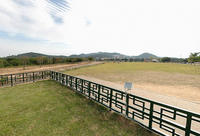You are in: Asia -> Korea, Republic of -> Gochang, Hwasun and ... , and traditional search or Image Gallery will yield results of this site only
Gochang, Hwasun and Ganghwa Dolmen Sites
| Site number: | 977 |
|
| Type of site: | Cultural | |
| Date: | 1000 AD | |
| Date of Inscription: | 2000 | |
| Location: | Asia, Republic of Korea, Koch’ang-gun County, Chollabuk-do Province; Hwasun-gun County | |
Up to 75 images are shown here. Click on each for more details or on Image Gallery for more images.
| Description: | The Gochang, Hwasun, and Ganghwa prehistoric cemeteries enclose several hundred examples of dolmens - burial places constructed of large stone slabs from the1st millennium B.C. They identify elements of the Megalithic culture, and though they are located in numerous places around the world, nowhere are they found in such a concentrated form. --WHMNet paraphrase from the description at WHC Site, where additional information is available. For 360 degree imaging of this site, click here. | |
| The Gochang, Hwasun and Ganghwa Dolmen Sites are the location of hundreds of stone dolmen which were used as grave markers and for ritual purposes during the first millennium BCE when the Megalithic Culture was prominent on the Korean Peninsula. The sites were designated as a World Heritage Site by UNESCO in 2000. Korea is said to contain more than 40% of the worlds dolmen, which are mostly concentrated in these three sites. The megalithic stones are invaluable because they mark the graves of the ruling elite. Pottery, comma-shaped jewels, bronzes, and other funerary artifacts have been excavated from these dolmen. The culture of the people during this time can be gleaned from the evidence left by the dolmen. Additionally, the stones show how stone was quarried, transported, and used to build dolmen. Dolmen in Korea have been dated to the seventh century BCE in locations such as Gochang and the practice ended around the third century BCE. The dolmen culture is linked with the Neolithic and bronze cultures of Korea. Excavation at the sites did not begin until 1965. Since, then multiple digs have been sponsored and an extensive program of inventory and preservation has been initiated by the Korean government. --Wikipedia. Text is available under the Creative Commons Attribution-ShareAlike License. For 360 degree imaging of this site, click here. | ||
| Source: | http://whc.unesco.org/en/list/977 | |
| Reference: | 1. UNESCO World Heritage Center, Site Page. | |







